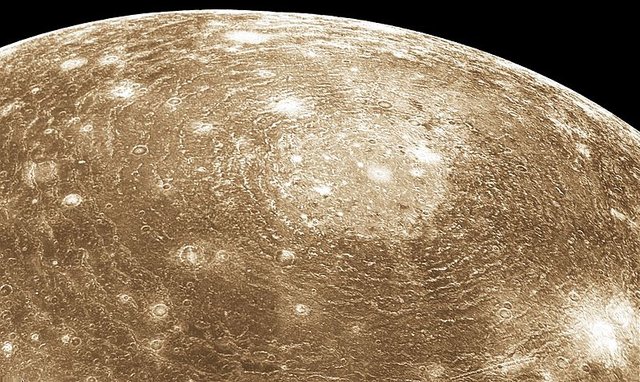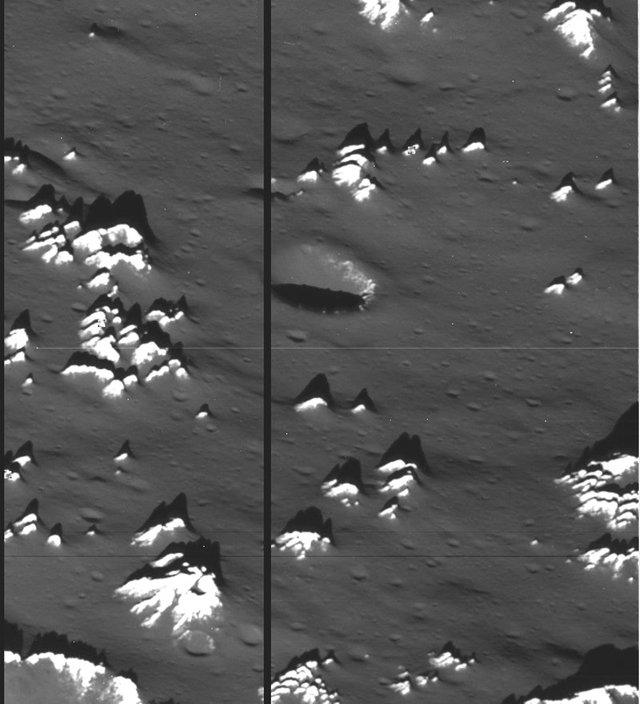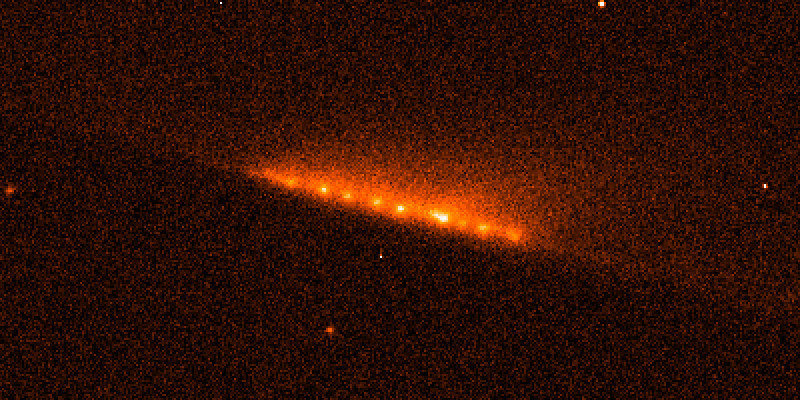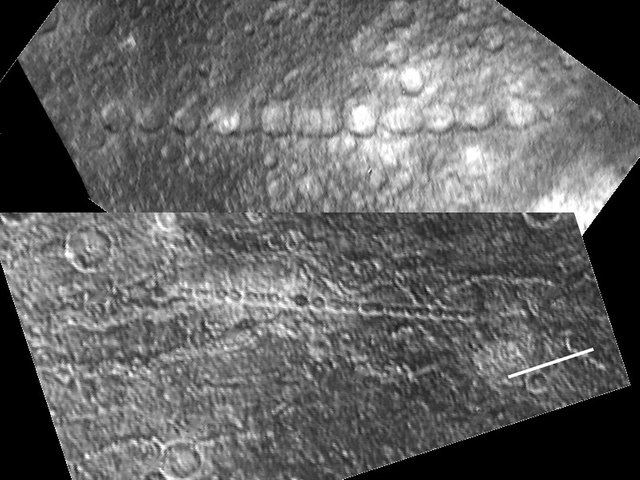Callisto – Jupiter’s Outpost Moon

Crescent Callisto from Voyager 1. Credit: JPL/NASA
Callisto is the outermost Galilean moon and is large with a diameter of 4820 km, the third largest moon and ousted in size only by Saturn’s Titan and the neighboring Ganymede. It is actually only slightly smaller than Mercury.

Click image to see an animation created in Celestia of Callisto.
Why the Outpost moon? The reason is that it would make a suitable base for future (manned) missions to Jupiter. It’s surface contains plentiful water ice and is far enough from Jupiter not to experience harmful levels of ionizing radiation which is encountered on the other Galilean moons. This radiation comes from charged particles being trapped and directed by Jupiter’s powerful magnetosphere. In 2003 NASA put forward the idea of a mission to Callisto in the 2040's as part of a study for Human Outer Planet Exploration (HOPE).

Artist impression of what a Callisto mission might look like in the future. Credit: NASA
Interesting Physical properties
There is evidence that Callisto also has a subsurface ocean layer deep below the surface, like Europa and Ganymede. There is quite a bit of uncertainty in how deep this is but the total ice/water layer is thought to go down to a depth of about 300km where it meets the rock/ice mantle. Although, the moon is tidally locked to Jupiter, so that the one face always points towards the planet, it does not participate in the orbital resonance of the other 3 Galilean moons. Consequently, most of the internal heating of Callisto is from radioactive decay.
At the very core the composition appears to be mostly rock and Iron. The percentage Iron in Callisto is rather low and this results in a lower overall density than the other Galilean moons. Consequently, the gravity is relatively weak for such a large body and the escape velocity of 2.4 Km/s is comparable to that of the earth’s moon.
The Surface

Valhalla Region on Callisto. Credit: Credit: JPL/NASA
Although in generally Callisto is quite dark there are brilliant areas of highly reflective ice in many places. There appears to a sublimation process occurring on the moon that causes the surface ices to slowly disappear leaving behind the dark non-volatile carbonaceous material. This process is suspected because there appears to be a trace Carbon Dioxide atmosphere. Sublimation appears to erode along a front, the tops of peaks/plateaus are protected by frost and the bottoms are protected by sands/carbonaceous material that have deposited out of the ice.

Callisto is believe to experience surface erosion cause by sublimation of CO2 ice. Sublimation occurs preferentially along the slopes of a crater or scarp wall (white arrows). Recondensation of CO2 ice forms at the tops of peaks (blue arrows) and the sandy lag (grey) remaining in the valleys inhibits sublimation in those areas. Credit: Author
There are many examples of the erosion process happening right across Callisto, one of the more spectacular examples are the "Pinnacles of Callisto" pictured here.

"Pinnacles of Callisto" a great example of Sublimation erosion on Callisto. Credit: JPL/NASA
Comet impacts

Hubble space telescope view of Comet Showmake-Levy in 1994, it went on to impact Jupiter in July, 1994. It is easy to see how the impact crater chains shown below would have been caused by a similar event. Credit: JPL/NASA/STScI
There are a number of peculiar impact crater chains the may be caused by disrupted comet’s. In 1993, Comet Shoemaker-Levy was captured by Jupiter and the resulting chaotic orbit disrupted the comet into a chain of fragments before it finally collided with the planet. Perhaps similar events could explain the following features.

Impact crater chains appear at a number of places and are likely caused by fragment comets or asteroids, disrupted by a close pass by Jupiter. Credit: JPL/NASA
Conclusions
This rounds out our look at the 4 large (Galilean) moons of Jupiter. These moons each have their own characteristics and geological processes. We look forward to when the new space missions from NASA and ESA arrive there later next decade and help uncover some of the mysteries that still surround these moons.
References
The Vision for Space Exploration. https://www.nasa.gov/pdf/55583main_vision_space_exploration2.pdf
Howard, A. D., and J. M. Moore (2008), Sublimation-driven erosion on Callisto: A landform simulation model test, Geophys. Res. Lett., 35, L03203, doi:10.1029/2007GL032618.
NASA data view. https://pds.nasa.gov/tools/release/addNVReq_win.cfm
Really nice post. Callisto is one of the only outer planet worlds that's actually somewhat feasible to land humans on. Really disappointed that nobody has landed a lander there yet.
Do you know how high those Callisto pinnacles are?
From what I have read "several hundred meters", so pretty impressive!
Thank you for writing this piece. I really appreciate hearing about how lesser known celestial bodies work, it makes me glad that many people are studying many different aspects of space and gives me hope for future human's explorations. Voted and Resteemed.
Being A SteemStem Member